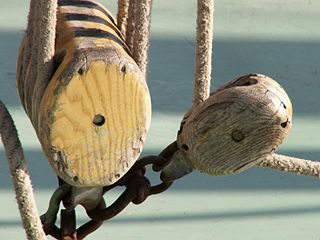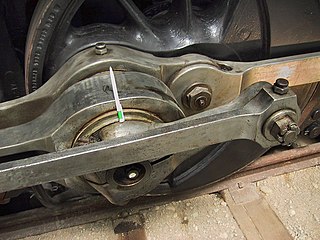
A pulley is a wheel on an axle or shaft that is designed to support movement and change of direction of a taut cable or belt, or transfer of power between the shaft and cable or belt. In the case of a pulley supported by a frame or shell that does not transfer power to a shaft, but is used to guide the cable or exert a force, the supporting shell is called a block, and the pulley may be called a sheave.

A camshaft is a rotating object— usually made of metal— that contains pointed cams, which converts rotational motion to reciprocal motion. Camshafts are used in internal combustion engines, mechanically controlled ignition systems and early electric motor speed controllers. Camshafts in automobiles are made from steel or cast iron, and are a key factor in determining the RPM range of an engine's power band.

Roller chain or bush roller chain is the type of chain drive most commonly used for transmission of mechanical power on many kinds of domestic, industrial and agricultural machinery, including conveyors, wire- and tube-drawing machines, printing presses, cars, motorcycles, and bicycles. It consists of a series of short cylindrical rollers held together by side links. It is driven by a toothed wheel called a sprocket. It is a simple, reliable, and efficient means of power transmission.

A transmission is a machine in a power transmission system, which provides controlled application of power. Often the term 5-speed transmission refers simply to the gearbox, that uses gears and gear trains to provide speed and torque block conversions from a rotating power source to another device.

A continuously variable transmission (CVT) is an automatic transmission that can change seamlessly through a continuous range of gear ratios. This contrasts with other transmissions that provide a limited number of gear ratios in fixed steps. The flexibility of a CVT with suitable control may allow the engine to operate at a constant RPM while the vehicle moves at varying speeds.

A serpentine belt is a single, continuous belt used to drive multiple peripheral devices in an automotive engine, such as an alternator, power steering pump, water pump, air conditioning compressor, air pump, etc. The belt may also be guided by an idler pulley and/or a belt tensioner.

A single-speed bicycle is a type of bicycle with a single gear ratio. These bicycles are without derailleur gears, hub gearing or other methods for varying the gear ratio of the bicycle.

A belt is a loop of flexible material used to link two or more rotating shafts mechanically, most often parallel. Belts may be used as a source of motion, to transmit power efficiently or to track relative movement. Belts are looped over pulleys and may have a twist between the pulleys, and the shafts need not be parallel.

The Pontiac straight-6 engine is a family of inline-six cylinder automobile engines produced by the Pontiac Division of General Motors Corporation in numerous versions beginning in 1926.

Chain drive is a way of transmitting mechanical power from one place to another. It is often used to convey power to the wheels of a vehicle, particularly bicycles and motorcycles. It is also used in a wide variety of machines besides vehicles.

A fork end, fork-end, or forkend is a slot in a bicycle frame or bicycle fork where the axle of a bicycle wheel is attached. A dropout is a type of fork end that allows the rear wheel to be removed without first derailing the chain.
A motion compensator is a device that decreases the undesirable effects of the relative motion between two connected objects. Motion compensators are usually placed between a floating object and a more stationary object, such as a vessel or a structure fixed to the seabed. The motion compensator does not prevent the motion, but tries to eliminate the negative effects of the movement. These negative effects include (1) the changes in force and stresses, and (2) the hysteresis, i.e., the rapid start-and-stop "jerking" of the objects.

The KV6 automotive petrol engine has a 24-valve quad-cam V6 configuration, and a pressurising variable-length intake manifold to add hot spots throughout the rev range. Variants exist in 2.0 to 2.5 litres capacities. These were built initially by Rover Group, then by Powertrain Ltd. KIA manufactured KV6 in Korea under licence. Production moved from the UK to China in 2005, re-designated NV6.
A hydraulic tappet, also known as a hydraulic valve lifter or hydraulic lash adjuster, is a device for maintaining zero valve clearance in an internal combustion engine. Conventional solid valve lifters require regular adjusting to maintain a small clearance between the valve and its rocker or cam follower. This space prevents the parts from binding as they expand with the engine's heat, but can also lead to noisy operation and increased wear as the parts rattle against one another until they reach operating temperature. The hydraulic lifter was designed to compensate for this small tolerance, allowing the valve train to operate with zero clearance—leading to quieter operation, longer engine life, and eliminating the need for periodic adjustment of valve clearance.
A marine riser tensioner is a device used on an offshore drilling vessel which provides a near constant upward force on the drilling riser independent of the movement of the floating drill vessel.
The following outline is provided as an overview of and topical guide to machines:
A guideline tensioner is a hydropneumatic device used on an offshore drilling rig that keeps a positive pulling force on the guidelines from the platform to a template on the seabed.

A conveyor system is a common piece of mechanical handling equipment that moves materials from one location to another. Conveyors are especially useful in applications involving the transport of heavy or bulky materials. Conveyor systems allow quick and efficient transport for a wide variety of materials, which make them very popular in the material handling and packaging industries. They also have popular consumer applications, as they are often found in supermarkets and airports, constituting the final leg of item/ bag delivery to customers. Many kinds of conveying systems are available and are used according to the various needs of different industries. There are chain conveyors as well. Chain conveyors consist of enclosed tracks, I-Beam, towline, power & free, and hand pushed trolleys.

Joy Global Inc. was a company that manufactured and serviced heavy equipment used in the extraction and haulage of coal and minerals in both underground and surface mining. The company had manufacturing facilities in Alabama, Pennsylvania, Texas, Wisconsin, Australia, Canada, China, France, South Africa and the United Kingdom. In 2017, Joy Global was acquired by Komatsu Limited and was renamed Komatsu Mining Corp.

A mechanical joint is a section of a machine which is used to connect one or more mechanical part to another. Mechanical joints may be temporary or permanent, most types are designed to be disassembled. Most mechanical joints are designed to allow relative movement of these mechanical parts of the machine in one degree of freedom, and restrict movement in one or more others.
































